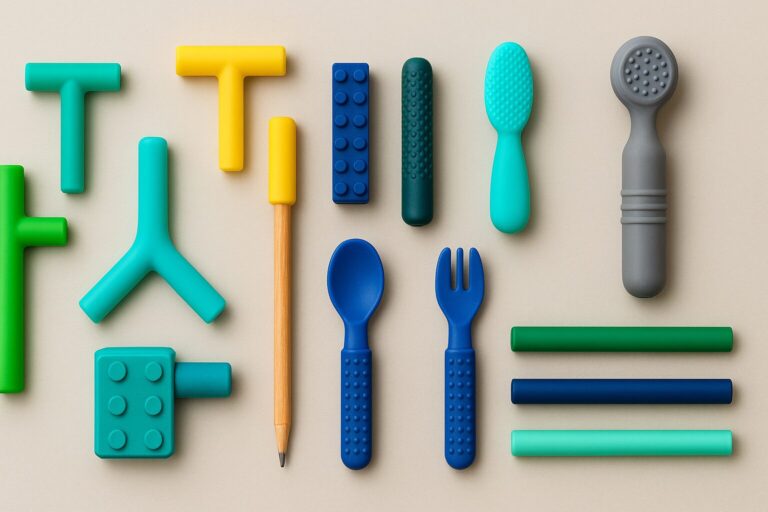For oral sensory seekers, safe chewing options can support calm, focus, and self-regulation at home, school, therapy, or work. This guide covers how to choose and use chewable pencil toppers, chewable tubes & straws, utensils, and oral massagers—plus cleaning, safety, and our favorite picks.
Take the 2-Minute Sensory Tool Quiz
We don’t sell products. We recommend tools based on sensory needs and may earn a commission from qualifying purchases (at no cost to you).
Who Benefits & How Oral Tools Help
- Oral seekers: meet sensory needs with safe, repeatable input (chew, suck, bite).
- Focus support: chewing can provide organizing input during class, homework, or work sessions.
- Self-regulation: rhythmic chewing can reduce fidgeting or mouthing non-food items.
- Oral-motor practice: some tools also support jaw strength and speech/feeding therapy goals.
How to Choose: Firmness, Shapes & Settings
| Factor | Options | Best For |
|---|---|---|
| Firmness | Soft • Medium • Firm | Soft = gentle chewers; Firm = heavy chewers |
| Shape | Flat bar • Tube • Textured or beaded | Flat for biting; Tube for jaw work; Texture/beads for extra input |
| Setting | Class • Therapy • Home/Work | Discreet looks for class; durable for therapy; style for home/work |
| Material | Food-grade silicone (BPA/latex/phthalate-free) | Easy to clean; consistent feel |
Chewable Pencil Toppers
Discreet, classroom-friendly oral input that fits most standard pencils. Reduces chewing on erasers, sleeves, or caps.
What to look for Checklist
- Firmness that matches chew strength (soft → firm)
- Low-profile shape for school or meetings
- Secure fit on pencil; easy to remove for cleaning
Low-Profile Barrel Topper
Why we like it: Simple, discreet cylinder design; great for school. Smooth bite feel.
Textured Toppers (Blocks)
Why we like it: Ridges add sensory feedback; helps with attention during writing tasks.
Firm Topper for Heavy Chewers
Why we like it: Durable for strong bite patterns; still comfortable for extended use.
Chewable Tubes
Chewable tubes can provide rhythmic input and support jaw work. They come in multiple shapes to target the oral input where it’s needed.
Types of tube chews
- Y-shaped
- P-shaped
- T-shaped
- Straight tube
Assorted Chew Pack (4 pcs)
Why we like it: Flexible silicone; dishwasher-safe; multiple shapes to trial in one pack.
Extra-Tough P-Tube for Aggressive Chewers
Why we like it: Built to withstand strong bite patterns; dependable daily-use durability.
Chewable Utensils & Straws
Chewable utensils and straws offer oral input during meals without drawing attention to chewing.
Choosing utensils
- Comfortable grip; safe bite area
- Dishwasher-safe silicone
- Neutral colors for older users; fun colors for kids
Chewable Utensils — Spoon & Fork Set (10 pcs)
Why we like it: Soft-touch handles; gentle texture; easy daily carry.
Straw Sticks (8 pack)
Why we like it: Hollow chew tube doubles as a straw; affordable multi-pack. Soft, not for aggressive chewing.
Oral Massagers (Vibration)
Vibrating oral tools can provide targeted sensory input and support oral-motor goals. Best used with therapist guidance.
When to consider vibration
- Seeks strong oral input or deep pressure
- Needs jaw/cheek/tongue activation in therapy plans
- Benefits from short, structured routines
Compact Oral Massager
Why we like it: Multiple tips; easy to sanitize; portable case.
Vibrating Wheel Sensory Chew
Why we like it: Chewable toy that vibrates for extra oral input; durable and rechargeable.
Care, Cleaning & Safety
- Material: Choose food-grade, BPA/latex/phthalate-free silicone.
- Cleaning: Warm soapy water or top-rack dishwasher (check product instructions).
- Inspection: Check for wear/tears; replace at first signs of damage.
- Sizing: Avoid small parts for younger children; supervise as needed.
- School-friendly: Keep designs discreet; discuss classroom expectations.
Explore more oral sensory supports in our Oral Sensory hub or compare options in Chewable Jewelry.
Frequently Asked Questions
Are chewable tools safe?
Choose reputable brands using food-grade silicone. Supervise younger users, inspect for wear, and replace when damaged.
How do I pick the right firmness?
Match to chew strength: soft for gentle chewers; firm for heavy chewers. If unsure, start with medium and adjust.
Can my child use these at school?
Yes, many classrooms allow discreet options like pencil toppers. Align with teacher or IEP/504 expectations.
How often should I replace chew tools?
At the first signs of cracking, tearing, or thinning. Frequency depends on chew intensity and usage.
What if chewing isn’t allowed?
Try alternative input: cold water sips, headphones, or quiet hand fidgets. Build a plan with school staff.
Not sure where to start? Get personalized ideas in under two minutes with our Sensory Toy Finder Quiz.


